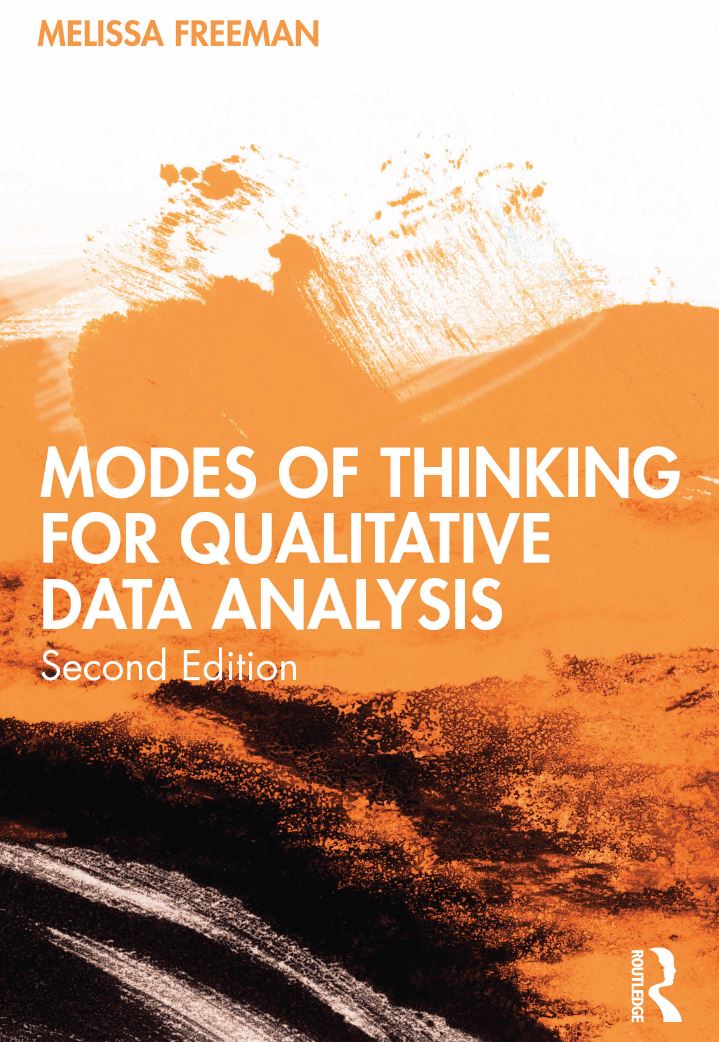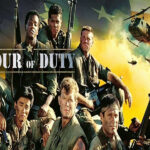- عنوان کتاب: Modes of Thinking for Qualitative Data Analysis
- نویسنده: Melissa Freeman
- حوزه: تحلیل داده
- سال انتشار: 2025
- تعداد صفحه: 193
- زبان اصلی: انگلیسی
- نوع فایل: pdf
- حجم فایل: 3.66 مگابایت
حرکت تحلیل چیست؟ چگونه از یک سوال، یک علاقه، یک حدس در مورد چیزی به ارائه یا شرحی از آنچه در مورد آن چیز از طریق تحقیق آموختهایم، حرکت میکنیم؟ الین آستون (2007)، محقق تئاتر فمینیستی، پیشنهاد میکند که ما تأمل فکری را به حالت تعلیق درآوریم و اجازه دهیم «عمل تجربی، فیزیکی، مادی و تجسمیافته، عملی که ذهن و بدن را در لحظه «ساختن چیزی» به هم نزدیک میکند» (صفحه 14)، فرآیند خلاقیت را هدایت کند. تصور تفکر به عنوان یک پدیده چندوجهی به من این امکان را میدهد که مستقیماً به چیزی بپردازم که آن را چالش اصلی پیش روی کسانی از ما که در حال آموزش و یادگیری تحقیقات کیفی هستیم، میدانم. چگونه میتوانیم رویکردهای تحلیلی متعدد مورد استفاده محققان کیفی را به گونهای درک کنیم که از برنامههای تحقیقاتی منحصر به فرد ما پشتیبانی کند، در عین حال ما را تشویق کند تا تفکر خود را گسترش دهیم و طرحهای تحقیقاتی را تصور کنیم که فراتر از محدودههای تجربه و آموزش رشتهای ما باشند؟ به اعتقاد من، این امر مستلزم نیاز به تفکر متفاوت در مورد رابطه نظریه-عمل است. جایگزینی ایده وجود یک روش درست برای انجام یک مطالعه تحقیقاتی – که فرض میکند پس از شناسایی روش درست، تنها کاری که باید انجام داد، پیروی از آن است – با مفهومسازی تحقیق به عنوان طراحی در حال ساخت؛ رویکردی که شامل بازنگری و بازاندیشی است و مقدمهای بر روشهای مختلف تلاقی نظریه و عمل در طراحی و به طور خاص در تحلیل را ضروری میسازد. آنچه باعث توسعه ویرایش اول این کتاب (روشهای تفکر برای تحلیل دادههای کیفی، ۲۰۱۷) شد، نارضایتی از منابع موجود برای آموزش یک دوره عمومی میانرشتهای در مورد تحلیل کیفی بود. در حالی که منابع متعدد و غنی برای انواع رایج تحلیل، به عنوان مثال، تحلیل موضوعی، تحلیل گفتمان انتقادی، تحلیل روایت وجود داشت، هیچکدام حوزه تحلیل را از خود استراتژیهای تفکر تحلیلی مفهومسازی نکرده بودند؛ استراتژیهایی که حرکات متمایز آنها در این رویکردهای متنوع نهفته است، اما شباهتها و تفاوتهای آنها اغلب تحت الشعاع جهتگیریهای روششناختی شکلدهنده آنها قرار میگیرد. علاوه بر این، کتابهای تحلیل دادههای کیفی که رویکردی کلی به جای رویکردی خاص به طراحی پژوهش کیفی دارند، در بیشتر موارد، دیدگاه محدودی از تحلیل کیفی به عنوان یک فرآیند رویهای شامل کدگذاری، دستهبندی و ایجاد مضامین ارائه میدهند. من به مقاله جوزف مکسول و باربارا میلر (2008) در مورد دستهبندی و ارتباط استراتژیها برای تحلیل کیفی، و همچنین مقاله دونالد پولکینگهورن (1995) در مورد پیکربندی روایت، به عنوان مقدمههای خوبی برای دستهبندی و ارتباط رویکردها به تحلیل اشاره کردم، ضمن اینکه به من کمک کردند تا نیاز به کتابی را که تخیل تحلیلی دانشجویان را فراتر از این دو رویکرد گسترش دهد (Lather، 2006) تشخیص دهم. به این ترتیب، من سه شیوه تفکر را به تفکر مقولهای و روایی اضافه کردم، یعنی تفکر دیالکتیکی، تفکر شاعرانه و تفکر نموداری. از زمان انتشار ویرایش اول، من نه تنها از این کتاب در تدریس تحلیل خودم استفاده کردهام، بلکه به دقت به نحوهی استفادهی دیگران از آن در پژوهشهایشان و بازخوردهای دریافتی از دانشجویان، همکاران و منتقدان در مورد آنچه که به عنوان نقاط قوت و محدودیتهای کتاب درک کردهاند، توجه کردهام. این ویرایش دومِ اصلاحشده مستقیماً از تشویقها و انتقادات سازندهی دریافتی سرچشمه میگیرد. در این ویرایش، تلاش میکنم تا در میان سایر مفاهیم ارزشی، منظور خود از «شیوه»، «تفکر»، «داده» و «تحلیل» را روشنتر کنم و همچنین فلسفهی تدریس خود را در فصل مقدماتی، نه به عنوان بخشی از نتیجهگیری، بیان کنم. علاوه بر این، تفکر استعمارزدایی را به عنوان شیوهی دیگری از تفکر متمایز از سایرین اضافه کردهام که به طور قابل توجهی در ویرایش اول غایب بود. تفکر استعمارزدایی یک ضمیمهی ضروری است، زیرا روشهای تفکری را ارائه میدهد که ریشه در معرفتشناسیهای غیرغربی دارند. من همچنین اصطلاح شاعرانه را به شاعرانه که از نظر دستوری صحیحتر است، تغییر دادهام و به پراکندگی نموداری که قابل فهمتر است، تغییر نام دادهام. به این ترتیب، شش شیوهی موجود در این ویرایش عبارتند از (1) تفکر مقولهای؛ (2) تفکر روایی؛ (3) تفکر دیالکتیکی؛ (4) تفکر شاعرانه؛ (5) تفکر پراکنده؛ و (6) تفکر استعمارزدایی. شیوههای تفکر برای تحلیل دادههای کیفی، جنبشهایی برای تفکر هستند. هر شیوه، شیوهای از «تفکر» یا فرآیندی برای معنابخشی را به اجرا در میآورد. در برداشت من از رویکرد عملی و گفتگویی به تفسیر که به عنوان هرمنوتیک فلسفی (گادامر، 1981) شناخته میشود، کلمه تفکر دارای بار معنایی کثرتگرایانهای است که آن را از ارتباط معمولش با تفکر عقلانی یا منطقی متمایز میکند. در چارچوب شیوههای به تصویر کشیده شده در این کتاب، تفکر در قالب یک جنبش تحلیلی خاص همراه با مفروضات هستیشناختی و اهداف روششناختی مرتبط با آن آشکار میشود و بنابراین نمیتوان آن را به یک درک عقلانی رسمی از اندیشه تقلیل داد.
What is the movement of analysis? How do we move from a question, an interest, a hunch about something into a presentation or account of what we learned about that something through inquiry? Feminist theatre scholar Elaine Aston (2007) suggests that we suspend intellectual reflection and allow “the experiential, physical, material, embodied practice, one which brings mind and body together in the moment of ‘making something’” (p. 14), to guide the creative process. Imagining thinking as a multimodal phenomenon allows me to jump right in to what I see as a core challenge facing those of us teaching and learning qualitative research. How do we make sense of the numerous analytical approaches used by qualitative researchers in ways that support our own unique research agendas, while also encouraging us to stretch our thinking and to imagine research designs that go beyond the confines of the limits of our experience and disciplinary training? This requires, I believe, the need to think differently about the theory–practice relationship; replacing the idea of there being a right way to carry out a research study—which assumes that once the right way has been identified all one has to do is follow it—with a conceptualization of research as design-in-the-making; an approach that embraces re-vision and rethinking, and necessitates an introduction to the many ways theory and practice intersect in design, and in analysis specifically. What prompted the development of the first edition of this book (Modes of Thinking for Qualitative Data Analysis, 2017) was dissatisfaction with the resources available for teaching a general interdisciplinary course on qualitative analysis. While there were numerous and rich sources for common types of analysis, for example, thematic analysis, critical discourse analysis, narrative analysis, there were none that conceptualized the field of analysis from the analytical thinking strategies themselves; strategies whose distinct movements are embedded within these varied approaches but whose similarities and differences often become overshadowed by the methodological orientations shaping them. In addition, qualitative data analysis books taking a general rather than a specific approach to qualitative research design presented, for the most part, a limited view of qualitative analysis as a procedural process involving coding, categorizing, and the creation of themes. I noted my indebtness to Joseph Maxwell and Barbara Miller’s (2008) article on categorizing and connecting strategies for qualitative analysis, as well as Donald Polkinghorne’s (1995) article on narrative configuration, as being good introductions to categorizing and connecting approaches to analysis, while also helping me recognize the need for a book that expanded students’ analytical imaginations (Lather, 2006) beyond these two approaches. As such, I added three modes of thinking to categorical and narrative thinking, namely, dialectical thinking, poetical thinking, and diagrammatical thinking. Since the publication of the first edition, I have not only used the book in my own teaching of analysis but attended closely to how others have taken it up in their scholarship, and to the feedback received from students, colleagues, and reviewers about what they perceived as the strengths and limitations of the book. This second revised edition grows directly from the encouragement and constructive criticisms received. In this edition, I attempt to make more clear what I mean by “mode,” “thinking,” “data,” and “analysis,” among other value-laden concepts, as well as to establish my teaching philosophy in the introductory chapter, rather than as part of the conclusion. In addition, I have added decolonial thinking as another mode of thinking distinct from the others, and notably absent in the first edition. Decolonial thinking is a necessary addition, as it provides ways of thinking that are grounded in non-Western epistemologies. I have also revised the term poetical to the more grammatically correct poetic and renamed diagrammatical to the more graspable diffractive. As such, the six modes included in this edition are (1) categorical thinking; (2) narrative thinking; (3) dialectical thinking; (4) poetic thinking; (5) diffractive thinking; and (6) decolonial thinking. Modes of Thinking for Qualitative Data Analysis are movements for thought. Each mode enacts a way of “thinking” or a process for sense-making. In my own grounding in the practical and dialogical approach to interpretation known as philosophical hermeneutics (Gadamer, 1981), the word thinking has a pluralistic connotation, distinguishing it from its usual association with rational or logical thought. In the context of the modes portrayed in this book, thinking unfolds in the shape of a particular analytic movement along with its related ontological assumptions and methodological aims, and cannot therefore be reduced to a formalized rationalistic understanding of thought (Williams, 2016). In a philosophical sense, then, modes are not styles, as the word might suggest, but possible configurations for thought and thinking. Additionally, analysis does not require processes of “segmenting and reassembling” (Boeije, 2010, p. 75) to be identified as analysis. Rather, analysis simply denotes the detailed examination of whatever information, or lack of information, might be considered evidence for the claims made as a result of the analytic exploration. As Marcus Weaver-Hightower (2019) aptly notes, “Just distinguishing an event as data represents analysis” (p. 4). In this second edition, my aim is to try to make more visible the distinct movement embodied within each mode of thinking. Also new to this edition is the inclusion of more recent examples, more emphasis on the contributions made to each mode by underrepresented scholars, as well as the inclusion of analytic activities I have found relevant to teaching a particular mode. Repeating what I wrote in the first edition, it is impossible to account for all the rich movements for thought occurring within analysis; nevertheless, I believe these six ways of thinking present distinct movements for analysis that, while coexisting, are also critiques of one another. Modes of Thinking for Qualitative Data Analysis, therefore, departs from the structure employed by other texts on qualitative research as it is neither a book on conducting qualitative research from beginning to end, nor does it provide procedures related to any one analytic approach, such as constant comparative analysis, or descriptions of the variety of methods linked to a specific methodology, such as narrative inquiry. Rather, the book seeks to describe the actions and aims engendered by each mode of thinking in order to deepen researchers’ understanding of these actions and aims. It is a conceptual analysis of the movement enacted through analysis and affirms the belief that imagination is essential to the analytical task. I agree with Maxine Greene (2001) that it is “imagination that enables us to challenge the fixed and the taken-for-granted, that allows us to open windows in the actual and disclose visions of what might be” (p. 110). Imagination is fueled when we consume the ever-expanding design configurations dreamed up by researchers near and far, and it is nourished by our own attempts to think differently about this practice called research. It is only in conversations with evidentiary material, with others, in person or virtually, and through exposure to how others think about research across the diversity of disciplinary conventions, that we can begin to break away from the narrowness of our own experiences and disciplinary roots. Importantly, this book provides a conceptual ground from which to understand a variety of analytic options, as well as identify the contributions different modes of thinking have made to the field of qualitative research. Furthermore, most studies use more than one analytical approach, which makes the presentation of these movements in one text fertile ground for qualitative design construction. In other words, understanding the actions inherent to thinking categorically or diffractively should enable researchers to consider how categorizing, for example, might contribute to other modes of thinking like dialectics. Putting these modes of thinking into dialogue with one another does not mean that their action or aim in each case will be the same. Quite the contrary, categorizing is going to serve a very different function in content analysis than it would when determining the parts of a plot for narrative thinking or when being deconstructed or entangled in dialectical or diffractive analytic movements. In addition, placing these modes of thinking side by side furthers conversations about incommensurablity, and the issues that may arise when seeking to mix modes of thinking that support different paradigmatic worldviews. Overall, understanding different modes of thinking for qualitative analysis is intended to support a deeper attention to analytic decision-making. I hope this book provides students and instructors of qualitative research with a variety of approaches that support well-established analytical options as well as open up spaces to advance what Keisha Green (2020) calls “an ‘otherwise’ epistemology and ontology in educational research” (p. 116). As an instructor, I do not believe we learn by being given answers to problems. We learn when we are given opportunities to dwell in complexities. I also believe that we learn about our own theoretical stance when we are pushed to consider a variety of, often contradictory, positions. My approach to teaching and learning honors all of the modes of thinking presented in this book. Although I have my preferences, my intention is to help the reader see and value this range and not to make “categorizing look bad,” as one of my students requested I mention in the Preface to this book. Her comment is helpful to consider because each mode of thinking is, in many ways, a critique of, and response to, the others, and so it would have been easy to tell a story of progress as I moved from categorizing to narrative and on to decolonial thinking. Instead, these are offered as equally important approaches to analysis with the hope that a deeper understanding of the kinds of knowledge they produce will prompt researchers to think more critically about the limitations and potentials, and very different effects, each mode of thinking puts into motion.
این کتاب را میتوانید از لینک زیر بصورت رایگان دانلود کنید:




































نظرات کاربران